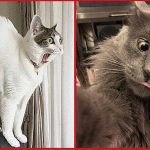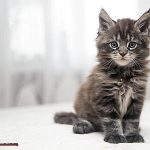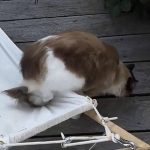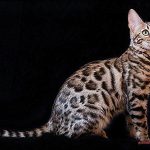As a devoted cat parent, nothing beats the joy of watching your furry friend play and explore. However, as much as we cherish their company, it’s crucial to keep an eye on any changes in their behavior or physical appearance. And one such change that might catch your attention is when your cat’s pupils are different sizes.
Have you ever noticed one of your cat’s eyes looking slightly different from the other? It’s not uncommon for one pupil to be bigger or smaller than the other, but it can be quite unsettling to witness. The question is: should we panic if our cat’s pupils are different sizes?
The answer isn’t straightforward. Anisocoria, or unequal pupil size in cats, can have various causes, some more concerning than others. It could be a natural variation in pupil size or age-related changes. But it could also signal underlying health issues that require immediate medical attention.
In this article, we’ll delve into the reasons why your cat’s pupils might differ in size and help you differentiate between harmless and worrying cases of anisocoria. So grab a cup of coffee, settle down with your furry buddy by your side, and let’s explore the fascinating world of cat pupils.
The Causes of Unequal Pupil Sizes
The size of their pupils can be a window into their overall health, and unequal pupil sizes, also known as anisocoria in veterinary terms, could be a sign of an underlying medical condition. Here are some of the potential causes of anisocoria in cats:
- Head Injury: A traumatic blow to the head can cause nerve damage that leads to unequal pupil sizes. This can be a serious issue that requires urgent medical attention.
- Inflammation: Inflammation of the eye, or uveitis, can cause the middle layer of the eye, called the uvea, to become inflamed. This inflammation can impact how the iris responds to light, leading to unequal pupil sizes. Uveitis can be caused by several factors such as infections or an autoimmune response.
- Medications: Certain medications used to treat seizures or anxiety may have side effects that cause pupil size differences. Always consult with your vet before giving any medication to your cat.
- Glaucoma: Glaucoma is a condition characterized by increased pressure within the eyeball. This pressure can damage the optic nerve and lead to vision loss. Anisocoria can be a symptom of glaucoma in cats, and if left untreated, it can cause blindness.
It is essential to note that unequal pupil sizes do not always indicate a severe underlying condition. Sometimes it could be just normal variation in a cat’s physiology. However, if you notice sudden or significant changes in your cat’s pupils, such as one pupil suddenly becoming significantly larger or smaller than the other, it is important to seek veterinary care immediately. Other accompanying symptoms such as redness or discharge from the eyes should also be monitored.
Symptoms to Look Out For
We can recognize when they’re feeling playful, when they’re hungry, and even when something’s not quite right. But what about their eyes? Unequal pupil size could be a sign of an underlying medical condition – and it’s crucial to know the symptoms to look out for.
Head trauma is one of the most common causes of unequal pupil size in cats. If your cat has suffered any sort of head injury, keep a close eye on their behavior. They may seem disoriented, lethargic, or have trouble walking. If you notice any of these symptoms, don’t hesitate to contact your veterinarian.
Neurological disorders like Horner’s syndrome can also cause uneven pupil size. This condition affects the nerves that run from the brain to the eyes and can cause changes in pupil size, droopy eyelids, redness in the eyes, and even a loss of sweating on one side of the face. If you notice any of these symptoms, seek medical attention promptly.
In some cases, unequal pupil size can be a symptom of much more serious conditions like brain tumors or epilepsy. If your cat experiences seizures or has other neurological symptoms like difficulty walking or coordination problems, it’s critical to get them to a veterinarian immediately.
Remember, if you notice that your cat’s pupils are different sizes, it’s essential to monitor their behavior closely for any other signs of illness or distress. Don’t hesitate to seek veterinary care if needed – as responsible pet owners, it’s up to us to ensure our feline friends stay healthy and happy.
Diagnosing Anisocoria in Cats
And when it comes to their eyes, one condition that should not be ignored is anisocoria – a noticeable difference in the size of their pupils. This could be a sign of an underlying medical condition that requires prompt attention. In this post, we’ll delve deeper into how veterinarians diagnose anisocoria in cats and what treatment options are available.
The diagnosis of anisocoria in cats requires a thorough physical examination of the eyes. The veterinarian will measure the diameter of both pupils and check for other abnormalities such as inflammation or injury. Additionally, they may perform additional tests such as blood work or imaging studies to determine the underlying cause of the anisocoria.
There are several potential causes of anisocoria in cats, including infections, neurological disorders, certain medications, and even trauma or injury to the eye. Depending on the cause, treatment options may vary from simple medications to surgery or other specialized interventions.
For instance, if the underlying cause is an infection, antibiotics may be prescribed to clear it up. If there is a tumor present, surgery may be necessary. In some cases, especially if the cause is neurological, treatment may involve managing symptoms rather than curing the condition.
It’s important to note that some cats may have naturally different-sized pupils without any underlying medical conditions. However, if you notice sudden changes in your cat’s pupil size or any other unusual behavior in their eyes, such as redness or discharge, it’s crucial to seek veterinary attention immediately.
Treatment Options for Anisocoria
One concerning issue that can arise is anisocoria, which causes uneven pupil size in cats. While anisocoria itself is not a disease or condition, it can be a sign of something more serious going on underneath the surface. Therefore, if you notice any changes in your cat’s pupil size, it is crucial to seek veterinary care immediately.
The treatment options for anisocoria depend on the underlying cause. In some cases, no treatment may be necessary, and the condition may resolve on its own over time. However, in other cases, prompt medical attention may be necessary to prevent further complications.
If inflammation is the root cause of anisocoria, your veterinarian may prescribe anti-inflammatory medications or steroids to help reduce swelling and inflammation. If the condition is due to an infection, antibiotics may be prescribed to treat it effectively.
On the other hand, if trauma or injury is the cause of anisocoria, treatment will depend on the severity of the injury. In such cases, your veterinarian may recommend surgery or other forms of treatment to repair any damage caused by the trauma.
Unfortunately, sometimes anisocoria can be a symptom of a more severe medical condition such as cancer or neurological disorders. In these cases, your veterinarian may suggest more advanced diagnostic tests like MRI or CT scans to determine the underlying cause and develop an appropriate treatment plan.
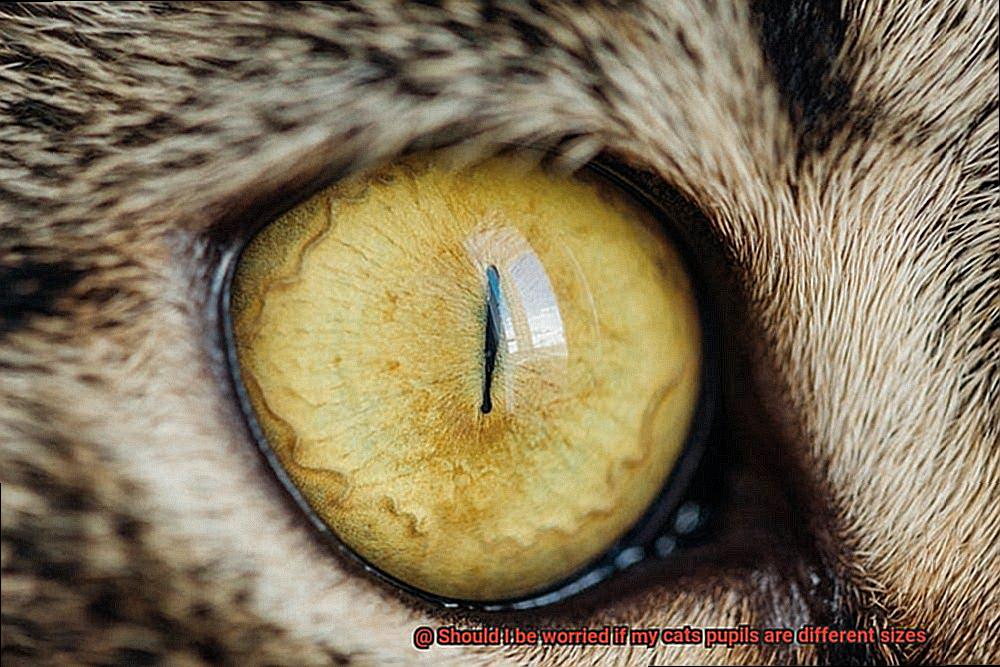
Therefore, if you notice any changes in your cat’s pupil size, don’t hesitate to seek immediate veterinary care. Your veterinarian will work together with you to develop a personalized treatment plan that meets your cat’s specific needs and helps them recover as quickly and comfortably as possible.
How to Prevent Anisocoria in Cats
One way to ensure that your cat stays healthy is by keeping an eye out for any changes in their eyes, particularly if you notice that their pupils are different sizes. Anisocoria can be a sign of an underlying health issue and requires immediate attention. Here are some tips on how to prevent anisocoria in cats:
Safe Environment
One of the most common causes of anisocoria in cats is injury or trauma to the eye or head. To prevent this from happening, it is essential to ensure that your cat’s environment is safe and free from potential hazards. Keep sharp objects out of reach, and supervise outdoor activities.
Regular Vet Visits
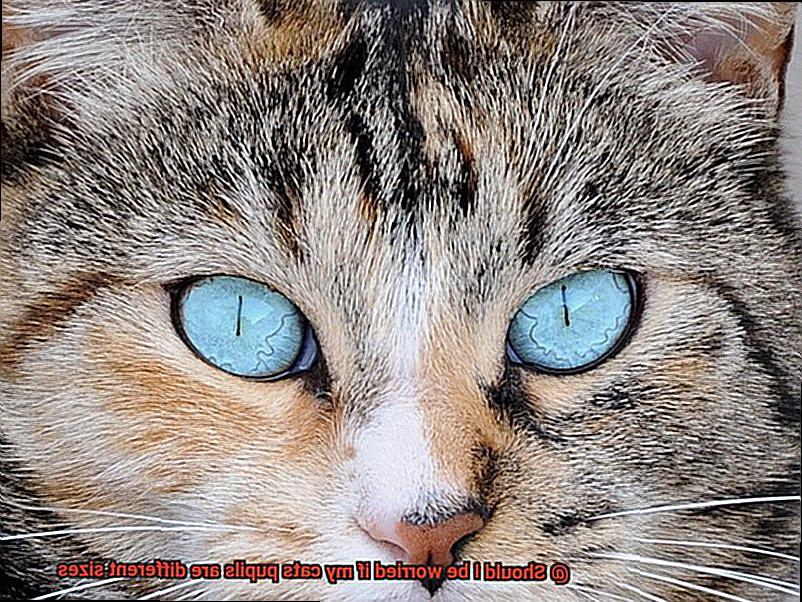
Regular check-ups with your veterinarian can help identify any underlying health issues early on before they become more serious. This is especially important for older cats or those with pre-existing conditions. By catching any issues early, you can prevent anisocoria and maintain your cat’s overall health and well-being.
Prevent Infections
Infections can also lead to anisocoria in cats. Keeping your cat clean and free from fleas and ticks can help prevent infections and keep your cat healthy. Additionally, a healthy diet and regular exercise can help keep their immune system strong.
Follow Medication Instructions
Certain medications can also cause anisocoria in cats. It is crucial to always follow your veterinarian’s instructions when administering medication to your cat and monitor them for any adverse reactions. By taking these measures, you can prevent anisocoria caused by medication.
Early Detection
If you notice any irregularities in your cat’s pupils, seek veterinary attention immediately. Early detection and treatment can make all the difference in your cat’s overall health and well-being. If caught early, anisocoria caused by underlying health issues such as neurological disorders or tumors can be managed and treated effectively.
When to Seek Veterinary Care for Your Cat’s Unequal Pupils
When it comes to their eyes, unequal pupils, or anisocoria, could be a cause for concern. Knowing when to seek veterinary care for this symptom can make all the difference in your cat’s health.
If you notice that your cat’s pupils are of different sizes and this is a new occurrence, it’s best to schedule an appointment with your veterinarian as soon as possible. This condition could indicate neurological issues like brain tumors, head trauma, or infections. It could also signal eye problems such as glaucoma, uveitis, or cataracts.
Apart from unequal pupils, other symptoms might accompany eye or neurological issues in cats. These include squinting, sensitivity to light, discharge from the eyes, lethargy, loss of appetite, and changes in behavior or mood. If you notice any of these symptoms along with unequal pupils, it’s essential to seek veterinary attention right away.
It’s worth noting that some cats may have naturally larger pupils in one eye than the other due to genetics. However, if you’re unsure whether or not your cat’s unequal pupils are normal for them, it’s always best to consult with your veterinarian.
Monitoring and Managing Your Cat’s Unequal Pupils at Home
One potential symptom that may cause alarm is anisocoria, or unequal pupil size. Although this can be a sign of serious underlying conditions, such as brain tumors or infections, it’s important to note that not all cases of anisocoria are cause for concern and may simply be a result of genetics or a minor injury.
To properly monitor and manage your cat’s unequal pupils at home, there are several key steps you can take. Firstly, regularly observing your cat’s pupils in varying lighting conditions can help you detect any sudden changes in size. If you do notice any sudden changes, it’s important to seek veterinary attention immediately.
In addition to monitoring your cat’s pupils, managing their condition is equally important. Your veterinarian may prescribe medication or treatment to address any underlying conditions causing the anisocoria. It’s also vital to keep your cat away from potential hazards that could injure their eyes and provide them with a cozy and comfortable environment for them to rest and recover.
It’s worth noting that cats with anisocoria may experience discomfort or vision impairment, so providing them with extra love and attention during this time is essential. You can offer them soft bedding, extra playtime, and plenty of cuddles.
The Impact of Stress on Cat’s Eye Health
Stress can manifest in various ways and cause their pupils to become different sizes. Chronic stress can also lead to serious eye problems, such as inflammation of the iris, glaucoma, and cataracts.
One common sign of stress affecting a cat’s eyes is dilated pupils. When exposed to stressors such as loud noises or unfamiliar environments, a cat’s pupils may dilate as an evolutionary adaptation to gather more information about their surroundings. However, prolonged exposure to stress can cause their pupils to stay dilated for an extended period, causing eye strain and discomfort.
On the other hand, chronic stress can cause the pupils to constrict, leading to unequal pupil sizes in cats. This condition is known as Horner’s syndrome and can be caused by damage to the nerves that control the muscles of the eye. If your cat displays these symptoms, it is crucial to seek veterinary attention immediately.
But what are the potential consequences of prolonged exposure to stress on your cat’s eye health? Chronic stress can lead to serious eye problems that can cause permanent damage to your cat’s eyes and even result in blindness. Inflammation of the iris, glaucoma, and cataracts are just some of the issues that can arise due to chronic stress.
As a responsible cat owner, there are several steps you can take to prevent stress-related eye problems. Pay close attention to your cat’s behavior and seek veterinary attention if they display any unusual symptoms. Reducing stress levels by providing a safe and comfortable environment for your cat is also vital in preventing eye problems caused by stress.
kSjv8uJn-ds” >
Conclusion
As a loving cat parent, it’s imperative to keep a close eye on any changes in your feline friend’s behavior or physical appearance. One such change that may catch your attention is when your cat’s pupils are different sizes. This condition is known as anisocoria and can have various causes, some more concerning than others.
While unequal pupil size could be a natural variation or age-related change, it could also indicate underlying health issues that require immediate medical attention. Some potential causes of anisocoria in cats include head injury, inflammation, medications, and glaucoma.
It’s crucial to monitor your cat’s behavior closely for any other signs of illness or distress if you notice sudden or significant changes in their pupils. Additionally, pay attention to other accompanying symptoms such as redness or discharge from the eyes.
If you notice any irregularities in your cat’s pupils, seek veterinary attention immediately. Early detection and treatment can make all the difference in your cat’s overall health and well-being. Your veterinarian will work together with you to develop a personalized treatment plan that meets your cat’s specific needs and helps them recover as quickly and comfortably as possible.
By regularly observing your cat’s pupils in varying lighting conditions, managing their condition through medication or treatment prescribed by a vet, providing them with a safe environment free from potential hazards, keeping them clean and free from fleas/ticks/infections, following medication instructions carefully, seeking veterinary attention promptly when needed, offering them extra love and attention during times of discomfort or vision impairment caused by stress-related eye problems caused by chronic stress; you can help prevent anisocoria in cats.
Don’t delay seeking medical assistance for your furry friend if you suspect they may have anisocoria. Your quick action could save their life.

